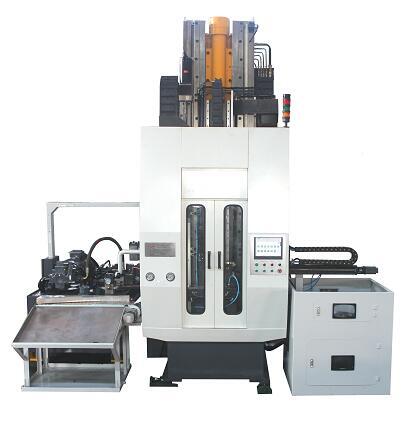Broaching Machines: A Comprehensive Guide

Introduction
Broaching machines are versatile metalworking
machines used to create complex shapes and profiles in a single pass. They are
highly efficient and can produce high-quality parts with tight tolerances. This
article provides a comprehensive overview of broaching
machines, including their types, applications, and
benefits.
machines used to create complex shapes and profiles in a single pass. They are
highly efficient and can produce high-quality parts with tight tolerances. This
article provides a comprehensive overview of broaching
machines, including their types, applications, and
benefits.
Types of Broaching Machines
There are two main types of broaching machines: horizontal
and vertical.
Horizontal Broaching Machines: These machines have a horizontal broach that
moves horizontally through the workpiece. They are ideal for broaching long,
slender parts.
Vertical Broaching Machines: These machines have
a vertical broach that moves vertically through the workpiece. They are
suitable for broaching shorter, thicker parts.
a vertical broach that moves vertically through the workpiece. They are
suitable for broaching shorter, thicker parts.
Applications
of Broaching Machines
of Broaching Machines
Broaching machines are used in a wide range of
industries, including:
Automotive: Broaching machines are used to create complex shapes
in engine blocks, transmission housings, and other automotive components.
in engine blocks, transmission housings, and other automotive components.
Aerospace: Broaching machines are used to produce
high-precision parts for aircraft, such as turbine blades, landing gear
components, and structural elements.
high-precision parts for aircraft, such as turbine blades, landing gear
components, and structural elements.
Medical: Broaching machines are used to create precision
instruments and medical devices, such as surgical tools, implants, and
prosthetics.
instruments and medical devices, such as surgical tools, implants, and
prosthetics.
Oil and
Gas: Broaching machines are used to
manufacture components for oil and gas drilling equipment, such as drill bits,
valves, and pumps.
Gas: Broaching machines are used to
manufacture components for oil and gas drilling equipment, such as drill bits,
valves, and pumps.
Benefits
of Broaching Machines
of Broaching Machines
Broaching machines offer several benefits,
including:
High
Efficiency: Broaching machines can
produce parts in a single pass, eliminating the need for multiple machining
operations.
Efficiency: Broaching machines can
produce parts in a single pass, eliminating the need for multiple machining
operations.
High
Precision: Broaches are precision tools
that can create parts with tight tolerances.
Precision: Broaches are precision tools
that can create parts with tight tolerances.
Excellent
Surface Finish: Broached parts have a
smooth, polished surface finish.
Surface Finish: Broached parts have a
smooth, polished surface finish.
Low
Tooling Costs: Broaches are
relatively inexpensive to manufacture and can be reused multiple times.
Tooling Costs: Broaches are
relatively inexpensive to manufacture and can be reused multiple times.
Automation: Broaching machines can be automated for increased
productivity.
productivity.
Broaching
Process
Process
The broaching process involves the following
steps:
1. Setup: The workpiece is secured in a fixture and the broach
is inserted into the machine.
is inserted into the machine.
2. Cutting: The broach is pushed or
pulled through the workpiece, removing material and creating the desired shape.
pulled through the workpiece, removing material and creating the desired shape.
3. Finishing: The broach is retracted and the
finished part is removed from the fixture.
finished part is removed from the fixture.
Broach
Design
Design
Broaches are designed with specific features to ensure optimal
performance. These features include:
performance. These features include:
Teeth: The teeth of a broach are the cutting edges
that remove material from the workpiece.
that remove material from the workpiece.
Shank: The shank is the body of the broach that holds
the teeth.
the teeth.
Pull Head: The pull head is located at
the end of the shank and is used to pull the broach through the workpiece.
the end of the shank and is used to pull the broach through the workpiece.
Pilot: The pilot is a small diameter section at the
front of the broach that guides it through the workpiece.
front of the broach that guides it through the workpiece.
Conclusion
Broaching machines are versatile and efficient
metalworking machines that can produce complex shapes and profiles with high
precision. They are used in a wide range of industries and offer significant
benefits, including high efficiency, precision, and low tooling costs. When
selecting a broaching machine, it is important to consider the type of parts
being produced, the required tolerances, and the desired level of automation.
With proper maintenance and operation, broaching machines can provide long-term
productivity and reliability.
metalworking machines that can produce complex shapes and profiles with high
precision. They are used in a wide range of industries and offer significant
benefits, including high efficiency, precision, and low tooling costs. When
selecting a broaching machine, it is important to consider the type of parts
being produced, the required tolerances, and the desired level of automation.
With proper maintenance and operation, broaching machines can provide long-term
productivity and reliability.